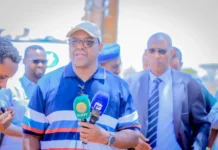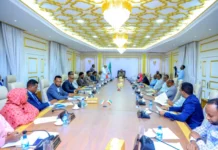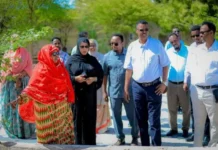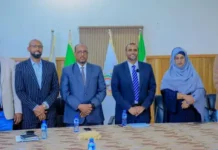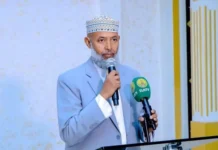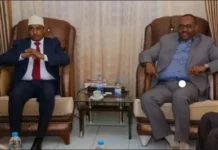Rebuilding lives also means rebuilding living spaces, and this is where Italian-born architect, Omar Degan, comes in.
“I feel that architecture and design play a key role in developing countries, but in particular post-conflict countries,” says Degan.

Public spaces mean different things in different countries. It has always been a powerful tool for social inclusion and is often taken for granted in developed countries, where parks and open spaces have made up the fabric of many urban environments for centuries.
Public space in itself can become a vital tool in the redevelopment of nations, particularly nations with a history of ruinous conflicts, such as the African country of Somalia. The country has been scarred by civil war and factional in-fighting, the aftermath of which persists to this day.
“I am confident that the proliferation of public space in this country is a major step towards its peace-building efforts, and a means to heal the scars of its turbulent past,” says Degan.

A Desire to Connect with Home
Born, raised and educated in Italy, Degan visited Somalia for the first time in October 2017. He felt a strong connection with the country, and with his education and training in emergency architecture, he felt that Somalia could make good use of the skills he had honed over the years.
Degan previously worked on slum upgrade projects in Buenos Aires and Hong Kong. Here he learned first-hand the importance of participatory planning (involving the community in discussions), environmental considerations and the using of local materials in rebuilding projects. Degan was inspired by the complex facets that accompanied this process.
“I chose Mogadishu for many different reasons, including the fact that it was probably one of the most developed cities in Africa before the civil war as well as during the 60s and 70s. It was this amazing city with amazing pieces of architecture, which have unfortunately all been destroyed.”
In his first three months in Somalia’s capital, he began work on a mosque and a school, which are both now near completion. He also used this time to conduct research and do a thorough assessment of the city’s needs and limitations.
.jpg?1550946072)
The Revival of Public Spaces in Mogadishu
Degan learned that before the war Mogadishu was rich in public spaces, with a significant proportion of land being allocated to gardens, parks, libraries, and healthcare facilities.
The Mogadishu he now knows has no public spaces. “The only public space is the beach which is actually not private yet. Apart from that, there is only one park in the city, which is private. It costs $1 to enter. Most of the population live below the poverty line, so they cannot afford that.”
While development is forging ahead, it’s not happening in a way that he feels takes the population and its context into account. He says the way development is occurring now further deepens the country’s existing levels of inequality. For example, basic services are made available in the inner city. But what about those on the outskirts; worse still, what about those internally displaced by the conflict?

Degan feels this is the consequence of a marked absence of government and industry in the rigorous planning required to rebuild any place. “The growth of the country is just happening without any kind of plan. No urban plan at all. No architectural plan at all,” he says.
Engineering and Profit over Architecture and Design
He believes firmly that this uneven distribution can be attributed to a lack of architectural and urban planning consultation in favor of engineering. There was also no consultation with the community, a step Degan cites as key in redevelopment.
The result is construction for the sake of construction, with no consideration of cultural identity and environmental factors.
He says that the engineering-focused developments and reconstruction are largely backed by the private sector, making the proliferation of public space a low-priority factor. “Obviously when you work in the private sector trying to talk about increasing public spaces or those kinds of things, they’re always more concerned with profit.”

So where does the architecture industry in Somalia fit into all of this? He is resolute in his response: “The architecture industry doesn’t exist. I would say Somalia used to offer many beautiful pieces of architecture that now are just memories. But right now there is no architecture to speak of.”
More than Mere Rebuilding
He has voluntarily taken on the role of shifting the focus to architecture by educating and sharing the practices. And he sees that working beyond simply rebuilding the structures that once stood. If the country is to make a success of its regeneration, it will build for what is relevant now.
He wants to demonstrate the ways in which public spaces can be used as tools for peace-building by integrating the population across classes, and including both rich and poor.
With Somalia’s history of internal conflict, a currently unstable political situation and its aspirations for regeneration, he feels that discussions around urban planning, as well as the needs of the population, must happen now.
Design to Heal Post-Conflict Countries
While he is working hard to revive Somalia’s architecture industry against the odds, Degan remains hopeful that if implemented, it would be the tool by means of which residents gain some semblance of a regular life free from conflict and its ravages.
“There’s a long way to go,” he says, “and I feel that architecture and design play a key role in developing countries, but in particular in post-conflict countries. People need beauty because they need to normalize their lives.”
“Architecture is a tool for building the nation. Sometimes architecture is used as a tool for showing off power in developing countries: in Somalia particularly, it is a tool that can move the people to appreciate daily life, to enjoy the spaces and develop pride in the country itself. For too long the narrative of this country was so bad, everyone forgot the good things before remembering the possibilities of tomorrow.”
Archdaily


